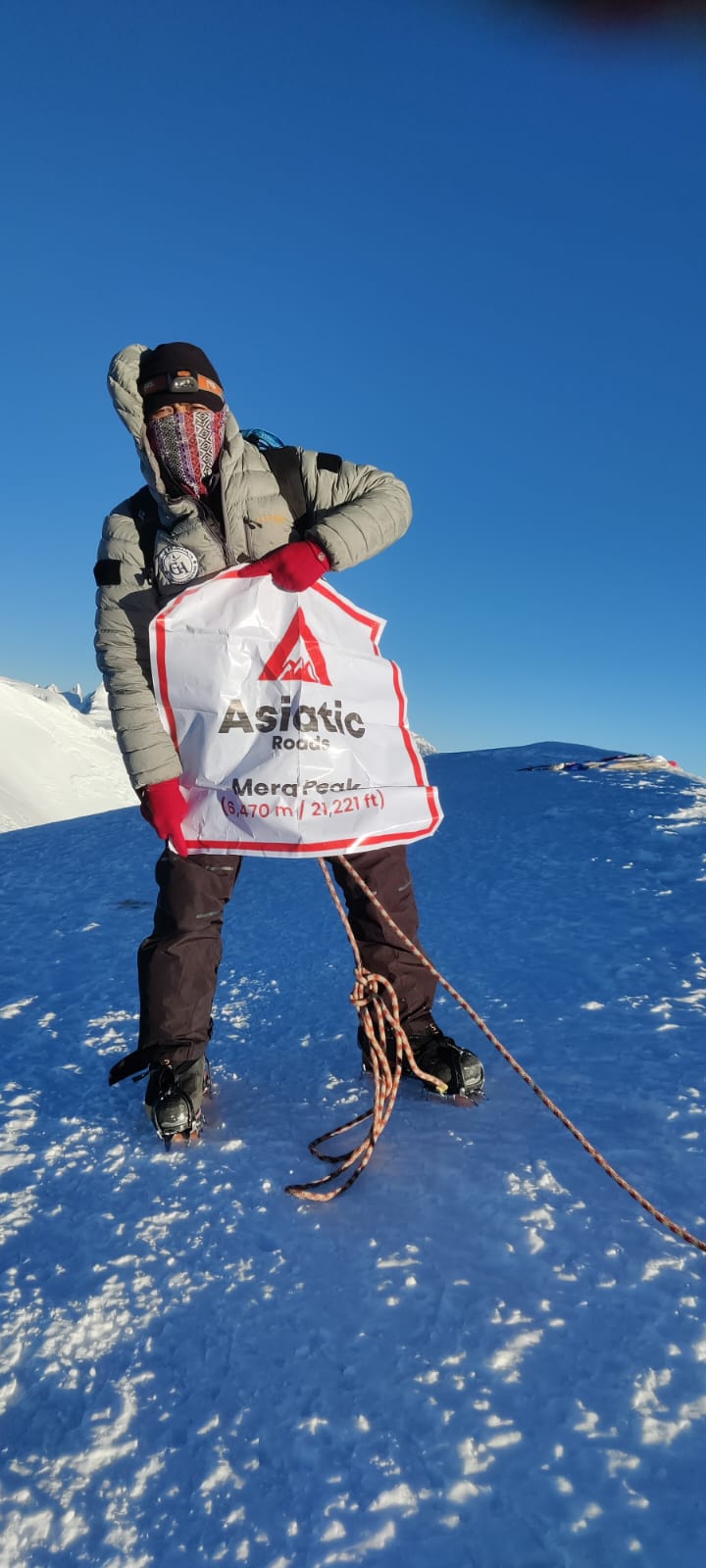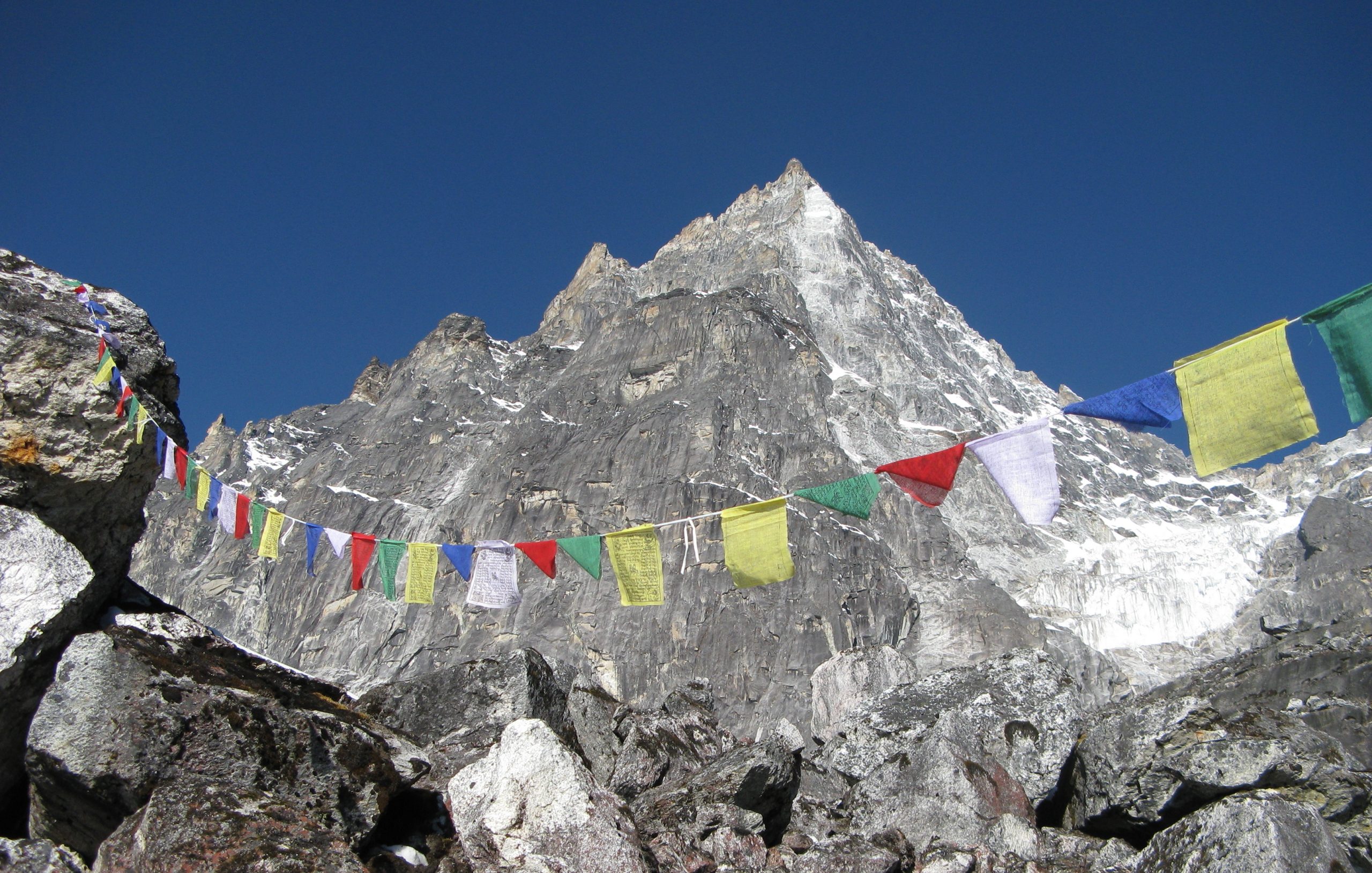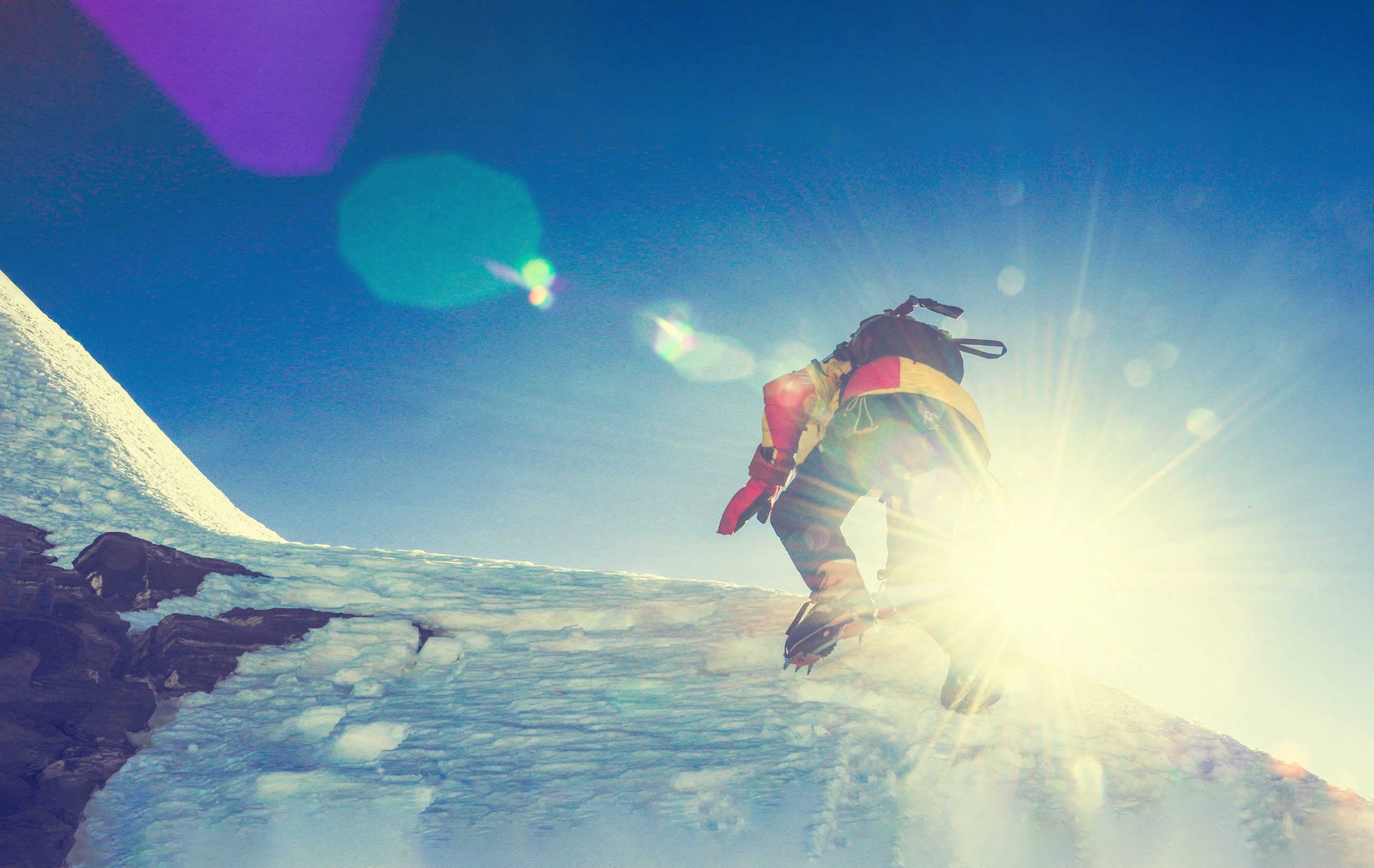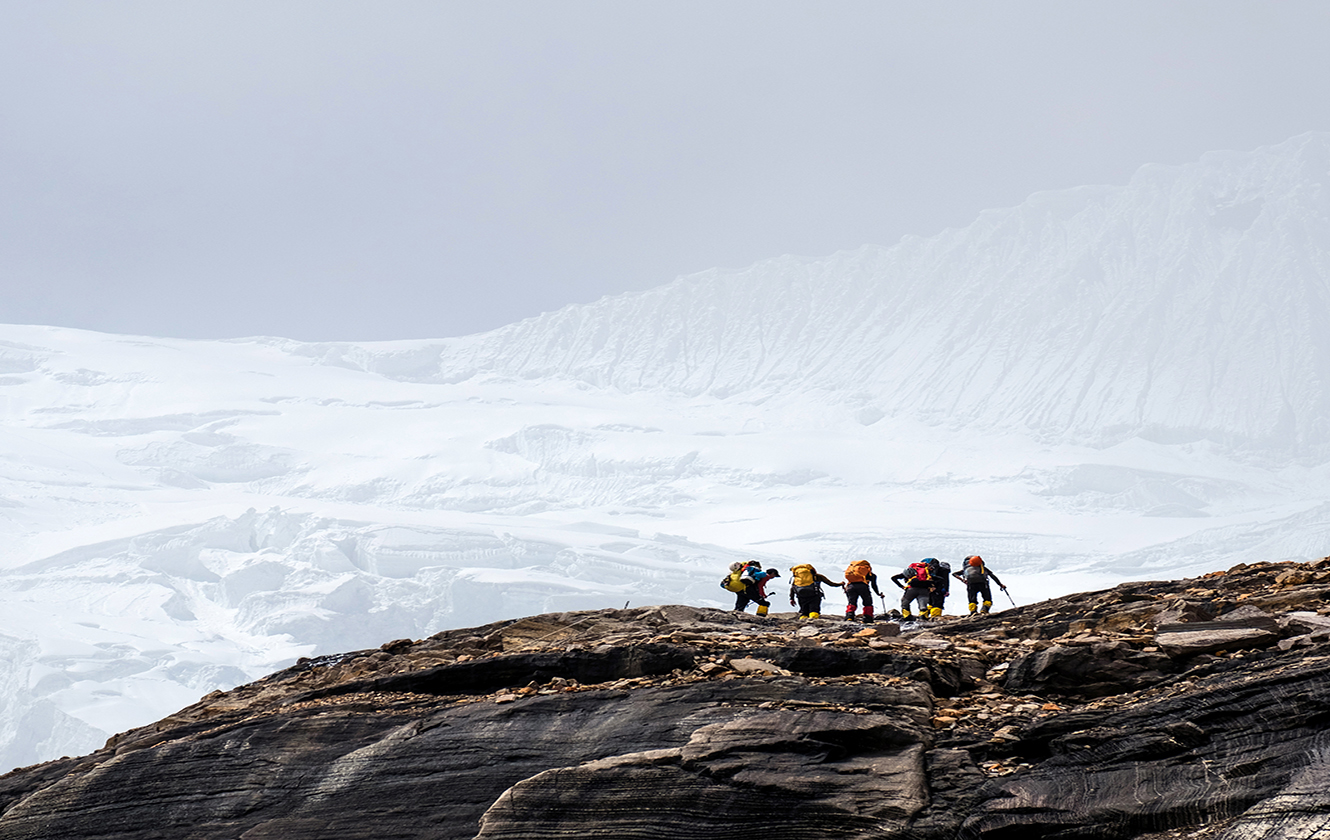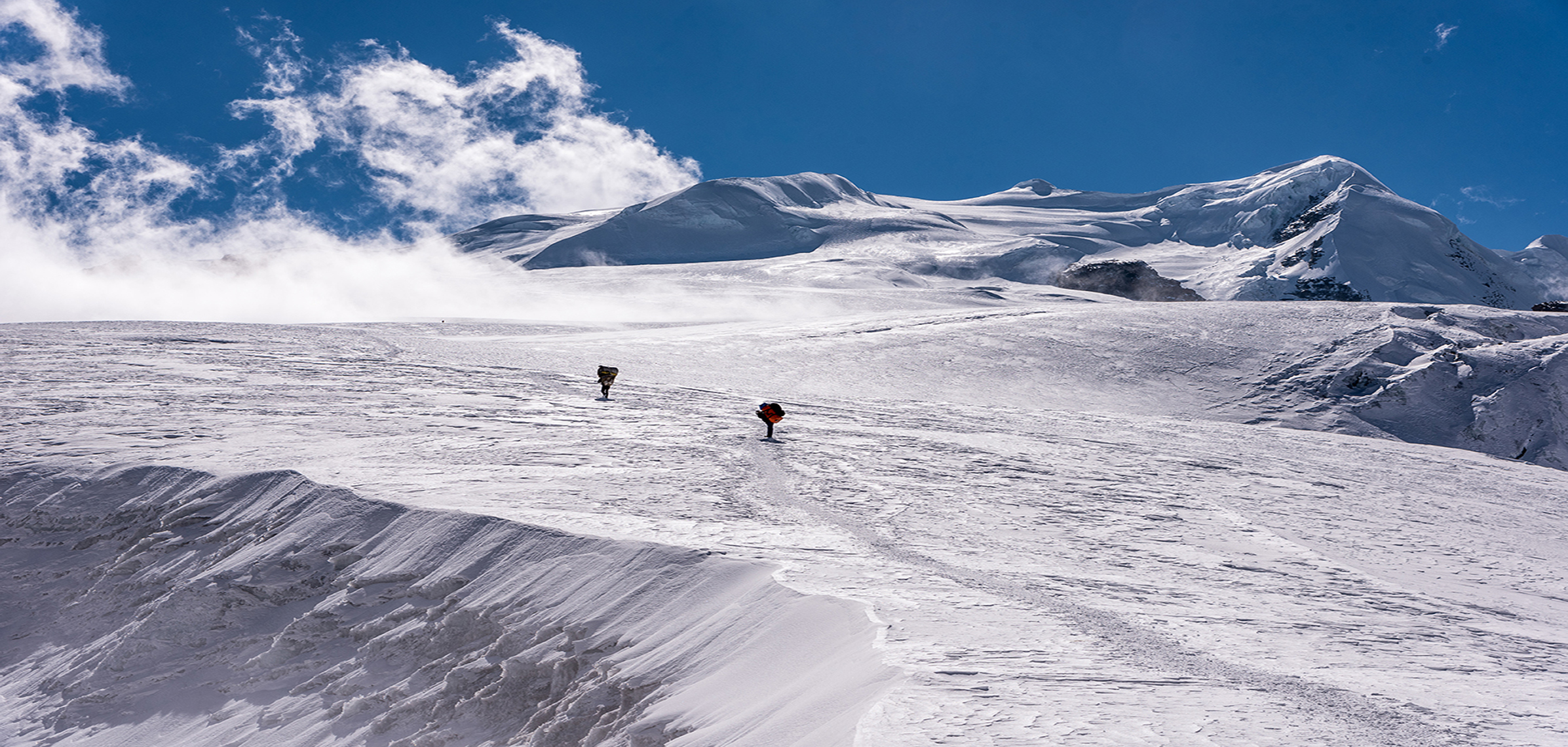
MERA PEAK
Elevation: 6,476 m / 21,241 ft.
- Home /
- Nepal /
- Peak Climbing & Expeditions /
- MERA PEAK
The bulk of Mera, officially the highest of Nepal’s permitted trekking peaks, rises to the South of Everest and dominates the watershed between the wild and heavily wooded valleys of the Hinku and Hongu Drangkas and is not truly speaking part of Khumbu Himal. It should also be noted that there is a discrepancy between the official height given by the Nepal Mountaineering Association (6,654m / 21,831ft) and the Schneider map (6,476m/21,247ft). Col. J.O.M. Roberts and Sen Tenzing made the first ascent of Mera in May 1953, by the now Standard route from the Mera La. It was during this season that Roberts made the first western exploration of the Lumding, Hinku (Inukhu), and Hongu valleys. It appears that Mt. Mera did not receive a Subsequent ascent until 1975 when French climbers Marcel Jolly, G. Baus, and L. Honills climbed the North peak, following the same route as Roberts but traversing along the connecting ridge to the further Summit.
Itinerary In Detail
-
Day 01: Arrival in Kathmandu.
Arrive at Katmandu Tribhuvan International Airport and meet, assist and transfer to the hotel by a representative from Himalayan Holidays.
At the hotel a short briefing about the trek and then check into the room.
Eve: Welcome Drinks and Dinner at an authentic Nepali restaurant.
Overnight at hotel.
-
Day 02: Gear Check and Orientation in Kathmandu
The day is free in Kathmandu for rest, last-minute shopping, gear check, and Trek / Climb Orientation in Kathmandu.
Dinner and overnight at hotel.
-
Day 03: Fly to Lukla & Trek to Chutanga (3,050 m / 10,004 ft.)
Early morning transfer to the domestic airport for the scenic 40 minutes flight from Kathmandu to Lukla “the Gateway to Mt. Everest”. On arrival at Lukla, met by Sherpa team and start trek to Chutanga: From Lukla the path traverses southeast through the forest, crossing several cascading streams. Above are a semi- circle of attractive rock peaks that form the ridge of the Kalo Himal, dividing the Khumbu valley from the Hinku. This unlikely-looking ridge has two passes, the Zatr Teng (4,943m/16,311ft) and the Zatrwa La (4,600m/15000ft).
The latter, with its gentler approach, is the more reliable –but be wary of the Zatr Teng when there is fresh snowfall on the Kalo Himal ridge. For those flying to Lukla, it is advisable to camp for a day or two below pass mainly for acclimatization. In a forest clearing between streams near Chutanga are some huge boulders from where you can explore the slopes towards Gonglha. It has a magnificent position that looks out over the Dudh Kosi towards Karyolung (6,511m/21,362ft), Numbur (6,959m/22831ft) and the south-east flank of Nupla.
Overnight at Tea house lodge.
-
Day 04: Chutanga to Tuli Kharka (4,400 / 14,436 ft.)
The trail passes through a small notch just east of the Zatr Og on the Sebuk Danda ridge. From the notch the path traverses a rugged, rocky country southeast below the ridge, rising gently to the Zatrwa La, marked by mani and chorten. The landscape is wild rocky and impressive. On the far side of the pass, the hillside falls steeply to the Hinku Dranka. The path not so well defined at first, drops toward a rugged, stream-filled, boulder-strewn valley. Tuli Kharka (4,400m/14,436ft) is a good site for the camp.
Overnight at Tea house lodge.
-
Day 05: Tuli Kharka to Tashing Ongma (3,500 m / 11,480 ft.)
From Tuli Kharka the path traverses the hillside, first southeastwards, crossing several spurs. The path is steep, and care should be taken crossing scree-filled washouts where the path may be ill-defined and loose. There are several points on the trail that give good views up the steep-sided Sanu Drangka to the South face of Mera. The Hinku hillsides hold abundant forests of tall blue Himalayan pine, hemlock, birch, and luxuriant rhododendron. Before the trail re-enters the forest after crossing the streams near Tashing Dingma, a multitude of alpine scrub zone plants decorate the hillside including the unusual ‘snowball flower’ (Saussurea gossypiphora). After traversing a while the path descends steeply through dense forests to the river. Branching rhododendron crouch over the trail swathed in tattered Usnea lichen which hangs like an old man’s beard from their limbs, filtering the sunlight and waving like weathered prayer flags in the wind. Tashing Dingma is a good camp spot at 3500m.
Overnight at Tea house lodge.
-
Day 06: Trek along Hinku River to Yak herders' camp at Tagnag (4,350m).
Following the west bank of the Hinku Drangka northwards, the forest eventually disappears and the valley widens and becomes much more open. There are no villages in the Upper Hinku, only small kharkas used for grazing goats, sheep, and yaks. The twin summits of Kusum Kanguru appear on the left while the valley is bounded on the right by the steep rock face of Mera’s satellite peak. Ahead framed in the sharp “V” of the valley is the imaginatively named Peak 43. We will take lunch at Gondishung, a summer herders’ settlement consisting of a few roofless huts and stone-walled enclosures, as well as a long ancient ‘mani’ wall of intricately carved prayer stones.
Beyond Gondishung we pass nearby a fascinating 200-year-old gompa built beneath a massive boulder and a number of crude mani walls. It is well worth visiting this gompa to burn some juniper at the shrine, an offering that just might ensure a successful ascent of Mera Peak. From the gompa, it is an hour’s walk over moraines to the Yak Herders settlement of Tagnag. Once similar in appearance to Gondishung, nowadays there are several teahouses here. The group will spend at least two nights at Tagnag (4350m) before moving up to Mera Basecamp.
Overnight at Tea house lodge.
-
Day 07: Acclimatization day
A day for acclimatization. One option for an acclimatization walk is to trek up the nearby ridge coming down from Kusum Kanguru, where we can reach an altitude of nearly 5000 meters and gain a spectacular view of our route onto the Mera La. At the leader’s discretion, part of today may also be used to run through various techniques and safety procedures to be used during the climbs.
Overnight at Tea house lodge.
-
Day 08: Trek beside Dig Glacier to Khare (Mera Base Camp) – (5,000m/16,400 ft.)
Heading up from Tagnag towards the Mera Basecamp at Khare, a good trail leads up and across the moraine which dams Charpatti Tal, and reaches a high point lined with cairns overlooking this glacial lake in about 30 minutes. From here the trail descends slightly to cross a sandy bowl and then climbs alongside a Khola or stream to the large pasture of Dig Kharka. Here we cross the Khola on stepping stones and then climb for a further hour and a half to Khare, the basecamp for Mera Peak at an altitude of approximately 5000 meters.
Overnight at Tea house Lodge.
-
Day 09: Acclimatization day and skills training
Another day for acclimatization. At the leader’s discretion, part of today may also be used to practice techniques and safety procedures to be used on our climbs. There are some interesting day hikes from Khare. Above camp, it is possible to climb to a high moraine ridge, from where there are good views of the Mera La and the route up the mountain. This will also be a time for the final preparation of our equipment and packing of our mountain bags.
Overnight at Tea house lodge.
-
Day 10: Climb Mera La (5,415m / 17,761 ft), the watershed of Hinku and Hongu valleys.
Leaving basecamp, we first climb to the crest of the moraine above Khare and then up a steep slope of scree or snow to reach a boulder-strewn bowl below the lower tongue of the Mera Glacier. We should reach this point in one and a half hours from Khare.
The route crosses the bowl and climbs the ground to the right of the tongue to a large rock platform beside the glacier. Here we will put on our crampons and climb 30 – 35 degrees snow or ice for 10 or 15 minutes to reach the plateau leading to the Mera La. Unless there has been recent snowfall, there will be a good trail that weaves its way around and between the crevasses toward the Mera La. It is about an hour’s walk across the plateau to reach the pass itself.
It is possible to camp in many places on the wide expanse of the Mera La or the trek leader may opt to drop down a short way on the Hongu side to a good, sheltered site that enjoys the early morning sun. The altitude at the Mera La is 5415 meters. Once the camp is established, our porters will descend back to Khare with instructions to return the following day to help carry to the high camp. The climbing group will spend the afternoon drinking as much tea and soup as possible to help with acclimatization.
Overnight at Camp.
-
Day 11: Climb easy snow slopes on Mera Peak to a high camp (5,800m / 19,024 ft.).
There are several options for a high camp on the mountain but the best by far is behind the pinnacles at approximately 5800 meters. Here there is shelter from the wind, usually no snow, and well-constructed platforms for several tents. It takes 3 to 4 hours to reach this site from the Mera La. After the first half an hour’s climb, the view north into the main Himalayas opens out. First of the 8000-meter giants in view is the red pyramid of Makalu, then Everest with its cloud plume peeking over the impressive black wall of Lhotse. Later you can see to the northwest the large white girth of Cho Oyu. Arriving at high camp, if the weather has been kind, the beautiful massif of Kangchenjunga comes into view, far to the East. Five of the World’s six highest mountains.
Overnight at Camp.
-
Day 12: Climb easy-angled snow slopes and steeper section to summit (6,476m / 21,241 ft.) & descend to Base Camp.
Early start around 3:00 am after breakfast. We have to put on Crampons and Rope before setting out for the summit. One of the great advantages of using our high camp, as well as making for a shorter summit day, is that we will have only around an hour of walking with head torches before dawn breaks.
Climbing mostly easy angled snow slopes to the foot of the dome of the central summit, we will place
a fixed rope for the last 30 to 40 meters. Which steepens to an angle of 45 – 50 degrees? Note that in certain snow conditions an ascent of the Central summit may be beyond the technical grade for this trek and in this case the group will make an ascent of the easier and slightly lower South summit. The trip leader will make this decision.From either top, the panorama of the Himalaya including five of the world’s highest peaks is unforgettable. From our high camp a well acclimatised party will take 3 – 4 hours to the summit. From the summit we will descend first to our high camp for some tea or soup and from here down to the Mera La and all the way back down to our advance base camp at Khare. A long but inspirational day!
Overnight at Tea house lodge.
-
Day 13: Back track to Gotay (3,600 m /11,808 ft.) following the Hinku River.
After breakfast, leave Khare and descent to the beautiful Hinku Valley as fast the forest camp at Gotay.
Overnight at Tea house lodge.
-
Day 14: Exit Hinku Valley to Tuli Kharka (4,320m / 14,170 ft.) below Zatrawa La.
Today we climb up through the lush forest on the west side of the Hinku Valley to Tuli Kharka below the Zatrawa La.
Overnight at Camp.
-
Day 15: Trek across Zatrawa La (4,600m / 15,088 ft.) and descend to Lukla (2840m).
The last 300 – 400 meters to the Zatrwa La will be our last climb of the trip. From the top we trek downhill for almost 2000 meters to Lukla.
Eve: Bid farewell to Sherpa Team.
Overnight at Tea house lodge.
-
Day 16: Fly to Kathmandu.
Early morning walk to the nearby Lukla Airport to board the 30 minutes flight to Kathmandu. Upon arrival meet, greet and transfer to hotel.
The rest of the day is free for most deserved rest.
Overnight at hotel.
-
Day 17: In Kathmandu / Contingency Day in case of delay.
This is a contingency day in case of delays to the Lukla flight. There is an optional complimentary guided sightseeing tour of the city’s main attractions. Alternatively, you may prefer to do your own thing, especially if you have visited Kathmandu before.
The city tour includes visit to the Hanuman Dhoka (Kathmandu Durbar Square) – an ancient durbar (palace) with its numerous old palaces, temples and pagodas, the Temple of Living Goddess “Kumari”, and the Kasthamandap Temple, which is believed to be constructed from the wood of a single tree from which Kathmandu derives its name. In addition also visit the Boudhanath Stupa – an ancient colossal stupa and the center of Tibetan Buddhism in the world and the Pashupatinath Temple- the Temple of Lord Shiva situated on the bank of the holy Bagmati River.
Pm: After lunch drive up to the Swayambhunath Stupa situated atop a hill from where you could get a bird’s eye view of Kathmandu Valley. The Swayambhunath Stupa is also known as the “Monkey Temple”!!
Eve: Group farewell dinner at nice restaurant in Thamel.
Overnight at hotel.
-
Day 18: Final departure.
Free until final departure to Kathmandu’s International Airport.
18 Days From
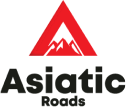
Any Question?
Feel free to call our travel experts.
+977 9851189018, +977 9801089018
info@asiaticroads.com
Whats Include and Exclude
Services Inclued
- All arrival, departure transfers in a private tourist vehicle.
- Four nights stay at hotel in Kathmandu (as above), inclusive of breakfast and taxes.
- Teahouse trek arrangement from Lukla to BC and back to Lukla inclusive of accommodation at local teahouse lodges, meals (breakfast, lunch and dinner)
- Camping arrangement in High Camp inclusive of all High Altitude gears, food and fuel etc.
- Services of Support team including support Sherpa and Porters etc.
- Trekking permit with all necessary documentation fees.
- Meera Peak Climbing permits from Nepal Mountaineering Association.
- Applicable garbage deposit.
- Climbing fees & equipment allowance for Mountaineering Guide (as above)
- Comprehensive medical kit and portable hyperbolic chamber.
Services not Inclued
- International airfares and airport departure taxes.
- Airfare for sector Kathmandu / Lukla / Kathmandu.
- Nepal visa fees.
- Personal Climbing Gears, Sleeping bags, Down jacket, etc. (See List)
- Items of personal nature such as bar bills, laundry, telephone calls, Internet, extra mileage, personal gratuities as tips to guides, porters, Sherpas, etc.
- Personal Insurance for Guests.
Other Costs (if Applicable)
| Particulars | Cost per person in US Dollars |
|---|---|
| Net per person cost in US$ (4 Star in Kathmandu) | US$ 2,896.00 - 3~4 Pax / US$ 2,741.00 - 5~6 Pax |
| Single room supplement (4 Star in Kathmandu) | US$ 250.00- 3~4 Pax / US$ 250.00 - 5~6 Pax |
| Net per person cost in US$ (5 Star in Kathmandu) | US$ 3,036.00 - 3~4 Pax / US$ 2,881.00 - 5~6 Pax |
| Single room supplement (5 Star in Kathmandu) | US$ 350.00- 3~4 Pax / US$ 350.00 - 5~6 Pax |
Cost Note
The costs mentioned above are net per person on a twin room/tent sharing basis, payable to us in US Dollars inclusive of all applicable government taxes, noncommissionable and valid till 31st Dec.
Notes:-
- Airfare for sector Kathmandu / Lukla / Kathmandu is US$ 360.00 which is subject to change without prior notice.
Accomodations
18 Days From

Any Question?
Feel free to call our travel experts.
+977 9851189018, +977 9801089018
info@asiaticroads.com
18 Days From

Any Question?
Feel free to call our travel experts.
+977 9851189018, +977 9801089018
info@asiaticroads.com
Reviews
In my 2 week stay, John was very professional and took me around to experience all that Kathmandu and surrounding areas has to offer. Sites were seen and many locals were met through John’s network.

Steven Stone
TravellerIn my 2 week stay, John was very professional and took me around to experience all that Kathmandu and surrounding areas has to offer. Sites were seen and many locals were met through John’s network.

Steven Stone
Traveller18 Days From

